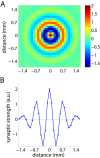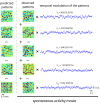On how network architecture determines the dominant patterns of spontaneous neural activity
- PMID: 18478091
- PMCID: PMC2374893
- DOI: 10.1371/journal.pone.0002148
On how network architecture determines the dominant patterns of spontaneous neural activity
Erratum in
- PLoS ONE. 2008;3(5). doi: 10.1371/annotation/2c9bfbcb-6b96-4d77-bfe3-10c5988150b8. Galán, Roberto F [corrected to Fernández Galán, Roberto]
Abstract
In the absence of sensory stimulation, neocortical circuits display complex patterns of neural activity. These patterns are thought to reflect relevant properties of the network, including anatomical features like its modularity. It is also assumed that the synaptic connections of the network constrain the repertoire of emergent, spontaneous patterns. Although the link between network architecture and network activity has been extensively investigated in the last few years from different perspectives, our understanding of the relationship between the network connectivity and the structure of its spontaneous activity is still incomplete. Using a general mathematical model of neural dynamics we have studied the link between spontaneous activity and the underlying network architecture. In particular, here we show mathematically how the synaptic connections between neurons determine the repertoire of spatial patterns displayed in the spontaneous activity. To test our theoretical result, we have also used the model to simulate spontaneous activity of a neural network, whose architecture is inspired by the patchy organization of horizontal connections between cortical columns in the neocortex of primates and other mammals. The dominant spatial patterns of the spontaneous activity, calculated as its principal components, coincide remarkably well with those patterns predicted from the network connectivity using our theory. The equivalence between the concept of dominant pattern and the concept of attractor of the network dynamics is also demonstrated. This in turn suggests new ways of investigating encoding and storage capabilities of neural networks.
Conflict of interest statement
Figures





References
-
- Cossart R, Ikegaya Y, Yuste R. Calcium imaging of cortical networks dynamics. Cell Calcium. 2005;37:451–457. - PubMed
-
- Froemke RC, Kumar VS, Czkwianianc P, Yuste R. Analysis of multineuronal activation patterns from calcium-imaging experiments in brain slices. Trends Cardiovasc Med. 2002;12:247–252. - PubMed
-
- Mao BQ, Hamzei-Sichani F, Aronov D, Froemke RC, Yuste R. Dynamics of spontaneous activity in neocortical slices. Neuron. 2001;32:883–898. - PubMed
-
- Cossart R, Aronov D, Yuste R. Attractor dynamics of network UP states in the neocortex. Nature. 2003;423:283–288. - PubMed
-
- Tsodyks M, Kenet T, Grinvald A, Arieli A. Linking spontaneous activity of single cortical neurons and the underlying functional architecture. Science. 1999;286:1943–1946. - PubMed
Publication types
MeSH terms
LinkOut - more resources
Full Text Sources

